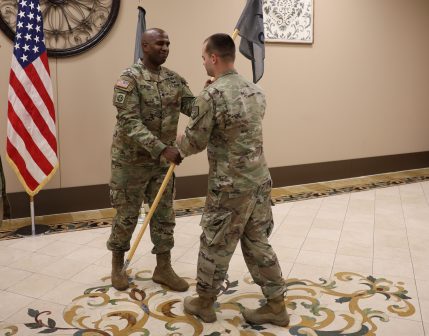Army working through intelligence and electronic warfare management on integrated platform

The Army is still working on an approach to manage signals intelligence information and electronic warfare information, which exist under different authorities, aboard its forthcoming integrated platform, FedScoop has learned.
The Terrestrial Layer System-Brigade Combat Team (TLS-BCT) is the first brigade-organic integrated cyber, electronic warfare and signals intelligence platform that will mounted aboard a Stryker vehicle. The first unit issued for the Lockheed Martin-built system is slated for the end of fiscal 2023.
Despite the distinct similarities between the two, signals intelligence and electronic warfare are governed under different authorities under U.S. law, the former under Title 50 and the latter under Title 10. Title 50 intelligence authorities are much more sensitive and closely held than Title 10 warfighting authorities.
“The Army is currently working toward resolving the issue of managing Title 10 and Title 50 data on the integrated Terrestrial Layer System (TLS) platform through establishment of explicit guidance on training requirements for EW Soldiers,” a spokesperson for Program Executive Office Intelligence, Electronic Warfare and Sensors told FedScoop Wednesday. “All EW Soldiers are directed to obtain the appropriate clearance before completing their training prior to reception at their gaining command. Additionally, all cleared Soldiers operating the TLS accredited for intelligence operations are responsible for understanding and applying Intelligence Oversight Procedures.”
In the converged battlefield of the future, executing and operating systems as a team — to include electronic warfare and signals intelligence — is the new norm, the IEW&S spokesperson said.
“When I was a lieutenant at Fort Drum, the SIGINT system … was at one end of the motor pool and the electronic warfare system, which was big, dangerous and scary, was … at the other end of the motor pool,” Lt. Gen. Lauran Potter, deputy chief of staff for intelligence, G2, said Wednesday at the Potomac Officers Club Army Summit. “To have those integrated on a single platform is really a testament to the excellent research and investment industry has been to allow us to be able to do that in an integrated fashion.”
Officials in the past have discussed how the Army is working on developing a so-called colorless network transport to allow the flow of intelligence and warfighting data on a single network. This means that data of all classifications could flow over the network with proper automated controls to ensure the right people are seeing the data instead of having a separate intelligence network and battlefield network.
Others have lauded the close partnership between the two communities from the TLS program’s inception.
“The real success story, if I look at the journey that TLS has been on over the past couple years, is the very, very close cooperation at the center of excellence level between the Intel Center of Excellence at Fort Huachuca and the Cyber Center of Excellence at Fort Gordon,” Potter said. “Starting from the initial pre-prototypes and soldier touchpoints, all the way up to when we field the system, that relationship between electronic warfare community and the SIGINT community is very close … We have really good cooperation between the EW and intel soldiers, really, at echelon.”






